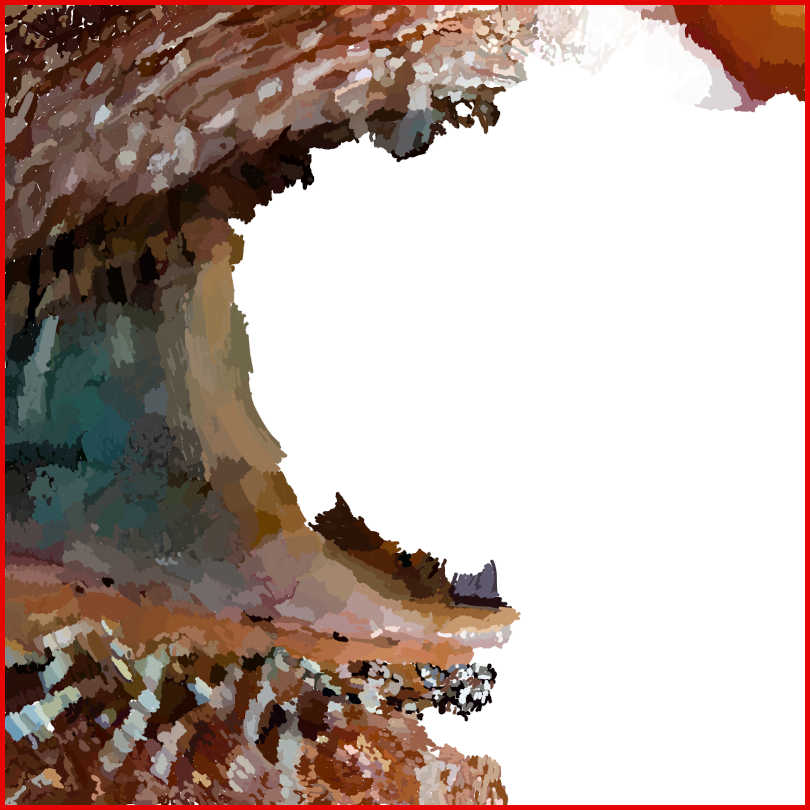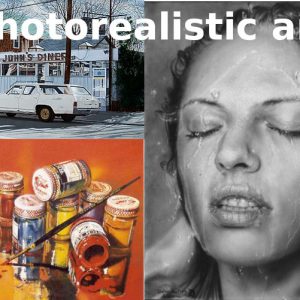Creative ways to draw with the Paintology App – Further study of the Block Coloring method.
I was thinking about extending the ‘block coloring’ method that I came across in my previous drawing of a great master painting using the Paintology app. Below is the final drawing of John Constable’s the Hay Wain Old that I did on my Samsung s6 tablet with a stylus.
John Constable the Hay Wain Old:

The technique relies on zooming in and blocking out small areas of colors based on the color picked using the color picker. It will be better to follow the video of this drawing that I put on my Ferdouse YouTube channel. Below is the actual video of the block coloring that I used to make this drawing.
Since using the block coloring method for this painting, I was excited to do more and filtered through many famous artworks of our time. Interestingly enough, I came across this great art site by the National Gallery of London, where they actually had some of the most famous artworks in history that you can see in high resolution. I was amazed! I can now go through the great masters and see their original brush strokes, simply fascinating.
Here is an excerpt of a small portion of the above painting by Constable just so you can see the details including the brush strokes.

In the above picture, you can see the fine details that the painter used to get an overall design of the scene. He was able to achieve this since the canvas he worked on was fairly large, 130.2 × 185.4 cm (51 x 33 inches)
I was amazed at how much detail the painter got onto his canvas, it was obvious he was an astonishing painter with attention to details.
The great beauty of working in the digital medium is that you can zoom into a drawing which is partly the reason, I could reproduce the original to a nice level. However, when looking closely, there were some details that were missed from the original but it does not detract the observer from thinking that it is the original. The clouds were something which I tackled at the end but this could also be improved in time.
You can see a question that I posted on Quora regarding this drawing.
Block Coloring using Paintology:
I was somewhat excited by the prospect of taking the technique of block coloring and applying to other great masters paintings. I also realized that I could equally apply the technique to any photographs of my choice and picked a photo that was visually appealing. It was only after I got into the painting that I realized the complexity of this drawing, so I resorted to my experience as an artist to complete the drawing.
Here is the original reference picture that I used for the drawing:

What I found is that the Hay Wain painting has a neutral balance to it and I could cover the whole screen with just block painting and final tweaks. However, when doing the eye above, I noticed sharp and defocused areas of the image which made the drawing more difficult with just the block method. This may have been a mistake on my part choosing this image but at that time I wasn’t thinking about this until I actually got into the drawing.
In a way, I was somewhat pleased that it ended up being more challenging, after all how else could I improve on this technique?
Here are the steps of the actual drawing made on my Samsung S6 tablet using the native stylus.


After going half way through, I realized that I hit a snag and this was that the original image had too many soft effects such as the eye ball. I knew that hard blocking was not going to cut it, so I postponed the drawing until the morning and let my mind swirl with potential ideas and solutions.
In the morning, I wasn’t that motivated to do this drawing, but I felt the urge to continue and complete this drawing. I decided to resort to my favorite brush, the shade brush of the Paintology app. The difficulty ‘blocking’ with the shade brush is that a few strokes are required to get the exact color tones. However, the brush is ideal for creating soft edges and to render the defocused areas of the original picture. I use it to good effect when I want a diffused background behind subjects.
I continued as much as I could while using the trace to use as reference only. To this extent, I could color larger areas within the regions such as the eyeball and the diffused look to the right.
The following screenshot shows how far I got with the shade brush.

After arriving at this stage, I wasn’t completely convinced where I was going with this. I thought about completing the drawing to be close to the reference image and calling it a day. This would be easy enough for me since I have made many drawings referring to the original reference photo.
Oddly enough, I decided to finish the drawing without too much references to the original picture and using my own judgement about this drawing. This is how creativity can take hold and a unique sense of form and style of the artist can become evident in their drawings and paintings.
I wasn’t sure how to go about it initially, so I thought about trying to just ‘improve’ it as much as I could. This meant any areas of the drawings where I saw some unusual contrasts that did not work with the overall picture. It was clear that the hard edges of the block coloring had many areas to address, which I did. Equally, the softer areas of the shade brush left too soft an edge that required building up contrast with the line brush.
I used a combination of the shade and the line brush. The line brush, I also adjusted the hardness to meet the soft edges of the shade brush and this turned out to be fairly effective. It is then I realized that thinking this way and experimenting can really expand the skillsets of an artist. So a good tip for other aspiring artist, is to always trust your feelings and don’t be afraid to experiment.
Here is the final drawing that I did with just using visual cues and my use of the line and shade brushes.

I felt more comfortable when I went with my feelings and continued drawing to the end. Any hesitancy was dismissed as I concentrated more on the work at hand.
As I look at this finished drawing, I was pleased with the result despite my hesitancy and doubts. However, when comparing with the original, I realized that the eyelashes at the bottom of the eye lobe was visible but not on the drawing. Nevertheless, I think you would agree that I did a reasonable job of this drawing.
Total time for drawing, approx. 5 hours.
I hope to bring you a video of this drawing that I will post on my YouTube channel and link from here.
Summary
In conclusion, I will continue my quest to discover more on the ‘block coloring’ technique. On my first initial attempts, the Constable painting was rendered easily with the block coloring but the realistic eye needed a combination of block coloring and shading. The beauty of each photographic image becomes more evident when one attempts to draw it but also a greater appreciation of colors and understanding of composition emerges.














 Digital Canvas
Digital Canvas
Leave a Reply